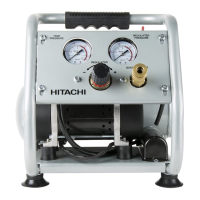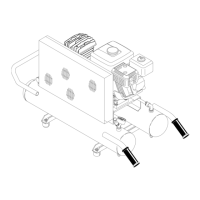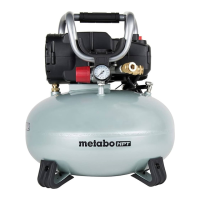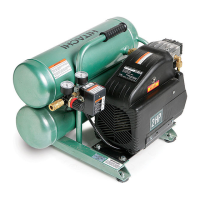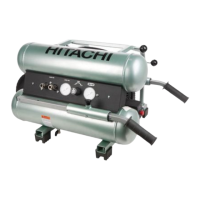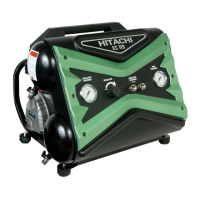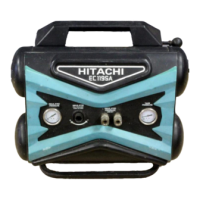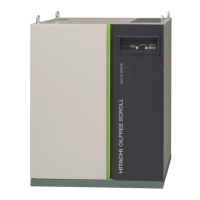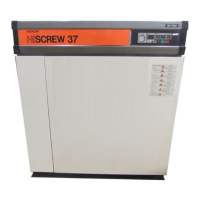English
— 5 —
13. NEVER USE COMPRESSOR FOR APPLICATIONS
OTHER THAN THOSE SPECIFIED.
Never use compressor for applications other than those
specifi ed in the Instruction Manual.
Never use compressed air for breathing or respiration.
14. HANDLE COMPRESSOR CORRECTLY.
Operate the compressor according to the instructions
provided herein. Never allow the compressor to be
operated by children, individuals unfamiliar with its
operation or unauthorized personnel.
Carrying the compressor if tilted may result in fuel
spillage.
15. KEEP ALL SCREWS, BOLTS AND COVERS TIGHTLY
IN PLACE.
Keep all screws, bolts, and covers tightly mounted.
Check their conditions periodically.
16. NEVER USE A COMPRESSOR WHICH IS
DEFECTIVE OR OPERATING ABNORMALLY.
If the compressor appears to be operating unusually,
making strange noises or vibration, or otherwise appears
defective, stop using it immediately and arrange for
repairs by a Hitachi authorized service center.
17. DO NOT WIPE PLASTIC PARTS WITH SOLVENT.
Solvents such as thinner, benzene, carbon tetrachloride,
and alcohol may damage and crack plastic parts. Do not
wipe them with such solvents. Wipe plastic parts with
a soft cloth lightly dampened with soapy water and dry
thoroughly.
18. USE ONLY GENUINE HITACHI REPLACEMENT
PARTS.
Replacement parts not manufactured by Hitachi may
void your warranty and can lead to malfunction and
resulting injuries.
Genuine Hitachi parts are available from your dealer.
19. DO NOT MODIFY THE COMPRESSOR.
Do not modify the compressor. Do not drill into, weld,
patch or modify the air tanks. Do not make adjustments
to the components that control tank pressure. Do not
make alterations to the factory operating pressure
settings. Do not operate at pressures or speeds in
excess of the manufacturer’s recommendations. Always
contact the Hitachi authorized service center for any
repairs. Unauthorized modifi cation may not only impair
the compressor performance but may also result in
accidents or injury to repair personnel who do not have
the required knowledge and technical expertise to
perform the repair operations correctly.
20. TURN OFF THE ENGINE SWITCH WHEN THE
COMPRESSOR IS NOT USED
When the compressor is not used, turn off the engine
switch and open the drain cock to discharge the
compressed air from the air tank.
21. NEVER TOUCH HOT SURFACE
To reduce the risk of burns, do not touch tubes, heads,
cylinder and muffl er. Never allow any part of your body
or other materials to contact with any exposed metal
parts on this compressor. Never allow any part of your
body to contact the muffl er or adjacent areas.
These areas can remain hot for least 45 minutes
after this compressor is shutdown. Cool down before
servicing.
22. DO NOT DIRECT AIR STREAM AT BODY.
Risk of injury, do not direct air stream at persons or
animals.
23. DRAIN TANK
Risk of bursting. Water will condense in the air tank. If
not drained, water will corrode and weaken the air tank,
causing a risk of the air tank rupturing. Drain tank daily
or after 4 hours of use. The drain contains moisture
in the air, abrasion particles, rust, etc. To drain the air
tank, open the valves slowly and tilt the compressor to
empty accumulated water. Keep face and other body
parts away from outlet of drain. Use ANSI Z87.1 safety
glasses with side shields when draining, as debris can
be kicked up into face.
24. MAKE SURE THE COMPRESSOR OUTLET
PRESSURE IS SET LOWER THAN THE MAXIMUM
OPERATING PRESSURE OF THE TOOL.
Too much air pressure causes a hazardous risk of
bursting.
Check the manufacturer’s maximum pressure rating for
air tools and accessories. The regulator outlet pressure
must never exceed the maximum pressure rating.
25. THE SAFETY VALVE MUST WORK PROPERLY.
Risk of bursting. Before starting the compressor, pull
the ring on the safety valve to make sure that the safety
valve operates smoothly. If the safety valve does not
work properly, over-pressurization may occur, causing
an air tank rupture or an explosion. Do not use the
compressor if the safety valve is stuck or does not
operate smoothly. Have the defective safety valve
replaced by a Hitachi authorized service center.
26. USE OF THIS PRODUCT WILL EXPOSE YOU
TO CHEMICALS KNOWN TO THE STATE OF
CALIFORNIA.
Some dust created by this product contains chemicals
known to State of California to cause cancer, birth
defects or other reproductive harm. Some examples of
these chemicals are:
- compounds in fertilizers
- compounds in insecticides, herbicides and pesticides
- arsenic and chromium from chemically treated lumber
To reduce your exposure to these chemicals, wear
approved safety equipment such as dust masks that
are specially designed to fi lter out microscopic particles.
Use of this product will expose you to chemicals known
to the State of California to cause cancer, birth defects
and other reproductive harm. Avoid inhaling vapors
and dust, and wash hands after using. This product
contains chemicals, including lead, known to the State
of California to cause cancer, and birth defects or other
reproductive harm. Wash hands after handling.
000BookEC2610Elowes.indb5000BookEC2610Elowes.indb5 2018/03/0910:24:482018/03/0910:24:48
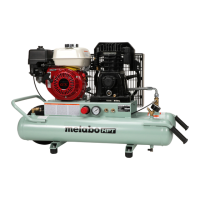
